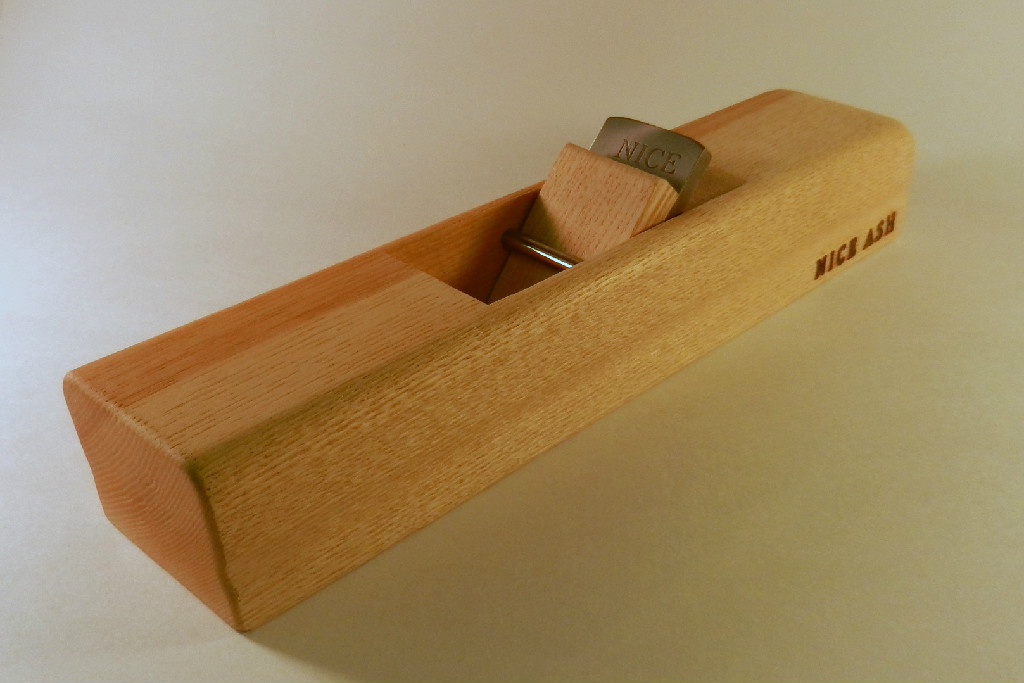We may receive a commission when you use our affiliate links. However, this does not impact our recommendations.
Between rounds of staring at two computer screens, I’m surfacing batches of rough-sawn cedar for their eventual destiny as two Adirondack chairs. You can guess which task is more fun.

I’ve been planing wood with a tool like this, a generous gift from community member Rhett Fulkerson. Click the image to visit Rhett’s group, Bluegrass Woodworkers Association.
I’m finding that it’s particularly fun to use a wood-bodied jack plane for initial straightening of the boards. Planing wood with wood is slightly different from using metal-bodied planes.
Planing wood – 3 differences between metal- and wood-bodied tools
1. Tool set-up. Since my first plane was a metal-body, I was surprised at how simple and intuitive the set-up is for wood bodies. All you need is your eyes, your hands and a small hammer. Place the plane on your bench, drop the blade and wedge into place, tap in the wedge and look at the base. Now tap the back of the blade so the edge protrudes from the plane mouth. Eyeball it and get it about right. Tap the wedge again to lock it tightly in place. Start planing wood and make adjustments as needed. You can adjust the blade to left and right by lifting the body and tapping the appropriate side of the blade.
2. Grip and rip. Unless your wood-bodied plane has a tote, gripping the tool is simply a matter of wrapping your hands around the front and back of the body. At first, it feels like something is missing. Your muscles get used to it. There’s something satisfying about planing wood with a hand tool that feels like the final product will feel.
3. Clean-up. When you’re done for the day, place your wood-bodied plane flat on the bench and tap the front of the body with your hammer a few times to loosen the blade and wedge. Remove the blade and wipe it down with a drop of rust-preventing oil. That’s it! With a metal-bodied plane you should also wipe down the body, so it takes a few more drops of oil.
It takes several tries to get accustomed to the whole process, but it’s good to have a couple different options in your tool chest for planing wood. Knowing both types of planes also gives you more options at used tool stores and flea markets. You can shop around for the best price.
Now that I know my jack plane pretty well, the next step will be learning how to use a wood-bodied smoothing plane. I’d love to see some tips from our community in the comments section! I’d also love to see everyone buy a copy of our Scott Meek DVD, “Make a Wooden Smoothing Plane,” which includes Scott’s expert tips on this entire topic.
Okay, I’ve been staring at the computer screen too long. Time for planing wood.
–Dan Farnbach
Here are some supplies and tools we find essential in our everyday work around the shop. We may receive a commission from sales referred by our links; however, we have carefully selected these products for their usefulness and quality.









I beg to differ on the point of backing out the wedge and blade at the end of the day. If your plane has a metal bar, perhaps. If you have a traditional plane with wood cheeks, there is not need to and it might even reduce the life of the plane. Broken cheeks are more often due to repeated removal hammering in of wedges and irons, along with over zealous wedge hammering than from their remaining in place. When the wood of a plane body expands and contracts, you may get splits across the toe and heel but not the cheeks. You can leave the wedge and blade in place without fear of the cheek splitting or becoming compressed.
If you are not gong to use the plane for an extremely long time, you can remove the wedge and blade and place them next to the plane. Just loosening them a little is asking for the blade to go flying and hit the floor when the plane is picked up. Bad idea all around.
Hi Dan,
Sounds like fun. I’ve got an old wooden jack plane that I’m tuning up now. I think you meant to say tap the back of the plane body to loosen the iron.